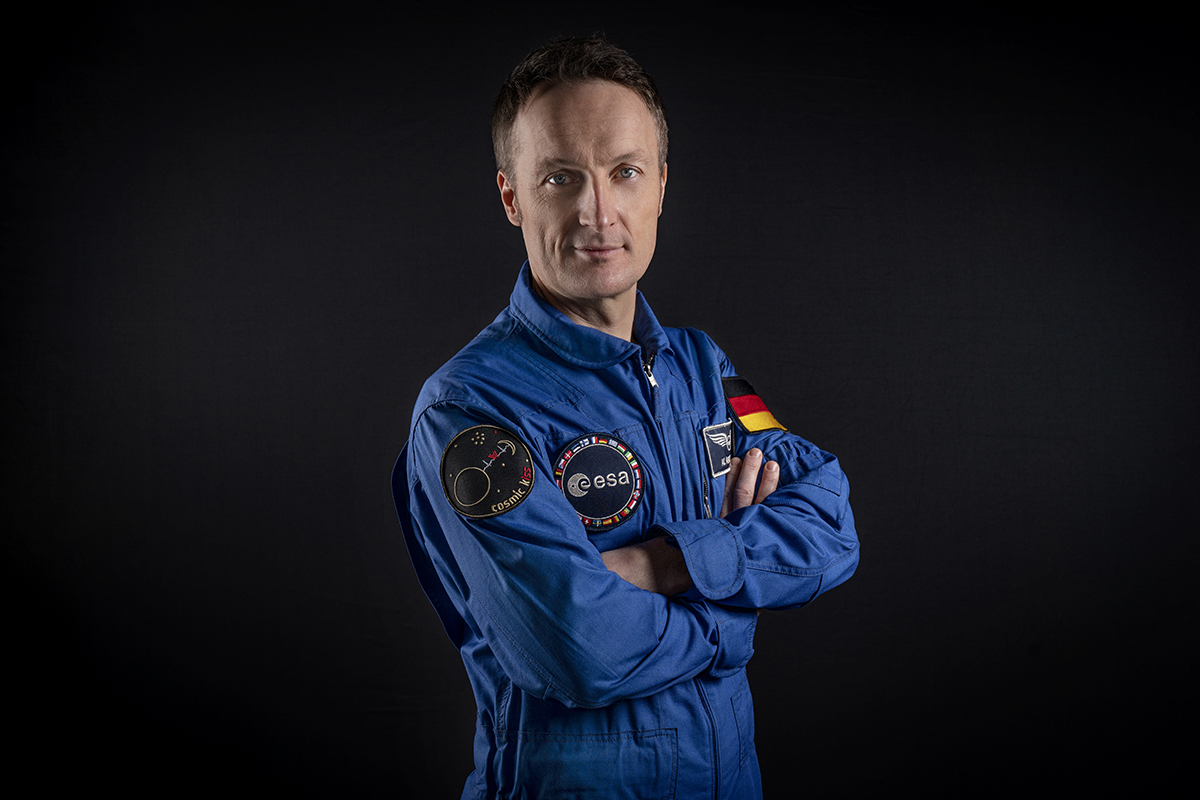- Becoming an Astronaut
- Living and Working on the ISS
- ISS Operations
- Space Science
- Exercising in Space
- Spacewalking/ Extravehicular Activities (EVA)
- Views from space & photography
- Spaceflight & Future of Space Exploration
Becoming an Astronaut
How long does it take to become an astronaut?
This seems like an easy question, but it’s also a complicated one. In my case it took quite a long time – 13 years between applying to become an astronaut and flying to space! So, in 2008 I applied and in 2021 I flew. But my way wasn’t the most straight forward way. I would say, usually, once you apply and are selected as an astronaut candidate you get basic training, which takes around one year and then later you get around two years of spaceflight training for your mission. The shortest way, I would say is three years. But now there are also the commercial spaceflights, and I think their training is only around six months to fly to space. But the mission is also completely different.
Living and Working on the ISS
What was the biggest change for you after you arrived on the ISS?
The biggest change was this shift of fluids in the body and, of course, the fact that space suddenly has three dimensions. That you lose things quickly, so to speak, and things float away quickly.
What laws apply on the ISS?
On the ISS, or in principle for every spacecraft, the law of the country that launched it is applied. But up here, of course, we have various modules that are tied together, i.e. American, European and Russian modules, and a Japanese module, and therefore there is an agreement between the international partners and this agreement regulates what happens and which rules apply to all of us. But in principle, every country that sends up a spacecraft is also responsible for it, as well as for disposing of it in the end.
What is everyday social life like on the ISS? Are there parties and do people sometimes argue?
Of course there are celebrations. We had Christmas up here, we had New Year’s, we had the birthday of my commander, cosmonaut Anton Shkaplerov. My birthday will come in the middle of March and of course we will celebrate that and we have also celebrated the other events together. There are no disputes here, but of course there are different opinions, or conflicts, but we have all learned in our astronaut training how to solve such conflicts properly before it comes to an argument. That is part of the astronaut training. The social life up here is great. We’re all super good friends, we work together, we eat dinner and lunch together, and on the weekends we watch movies together.
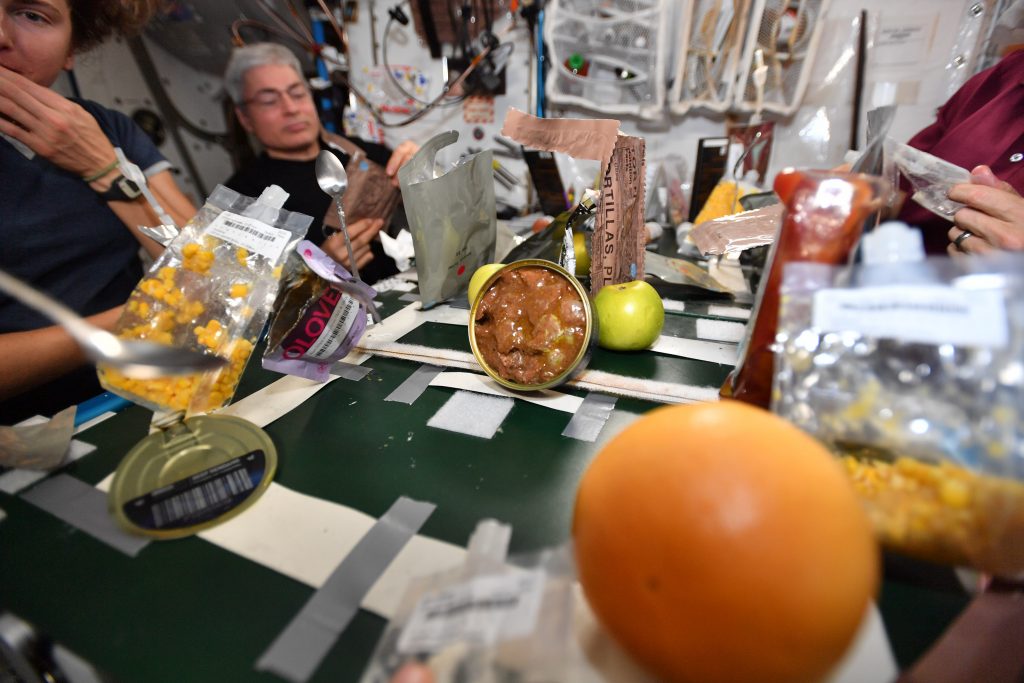
Thanksgiving dinner on the Space Station. Credits: NASA/ESA-M. Maurer
What was the most frightening experience for you on the ISS?
The most frightening experience was at the very beginning of my mission. A satellite broke apart. That was three or four days after we arrived and we received the message: There’s debris on a counter-course heading towards you. We all thought, hopefully we don’t have to fly home now, because then it would have been a short trip.
What do you do in the event of a serious medical emergency?
Well, of course we have some equipment with us to be able to solve certain emergencies ourselves. We have an ECG with us and gear to perform CPR. If it’s really bad and we can’t solve it ourselves up here, then of course we take the patient and fly back to Earth. But otherwise, we have very good equipment on the station. We have ultrasound equipment and we have the doctors on the ground who we can call in and they can give us instructions on what to do.
How long does it take to fly across the ISS?
Well, I have to push myself off on one side and then I can float over to the other side. I would say that’s done in 20 seconds. I can also fly faster, but of course you have to be careful that you don’t fly too fast and then ram into something and maybe hurt yourself. But it’s very fast and floating is also a lot of fun.
How much free time do you have and what do you use it for?
Well, I have a pretty busy day, but in the evening, after seven pm, that’s about when my free time starts, and that goes on until ten pm, when I’m officially supposed to go to bed. But most of the time I go to bed at eleven pm. During that time, I write e-mails or make small video clips and take a lot of photos of Earth. These are the things that I also post on social media. Every now and then we watch a movie together, that’s about once a week, usually on Friday evenings.
How fast is your internet speed to Earth and how is the signal transmitted?
The signal is transmitted via Ku band, that’s the same band we use for video and data up and downlink from the ISS and we can also communicate via Ku. We have four channels for communication, two are Ku and the others are S band. The internet speed is quite good, and we can even stream TV shows on board.
Vacuum cleaning in space: Where does the dust come from and is this an exhausting exercise?
Well, the dust actually comes from us humans, meaning skin particles and hair, and also from our clothes. For example, we mainly wear cotton clothing, and, except for during sports, don’t use polymer materials because the charge could damage some of the equipment that we have here. Also, the towels we use to wash ourselves are lint-free. Vacuum cleaning is actually a fun exercise. We must hop from one ventilation inlet to the next one, as that’s where the dust gets sucked in by the air conditioning system and so we have to clean all the grids. The most difficult thing is all the cables that float around like snakes and tend to wrap around everything in weightlessness. I mean, who likes house cleaning? But it’s really not exhausting. It’s just a thing we have to do for our own benefit to keep the Station clean and prevent dust coming in our eyes or throats.
Does sleeping and dreaming feel different in space?
Well, I sleep super well up here, almost better than on Earth. It’s like being wrapped in a cotton ball. Unfortunately, I don’t dream, neither on Earth nor up here. That’s a bit of a shame, because I was actually also wondering how that changes. So, unfortunately, I can’t answer that question.
Where did the Japanese spaceflight participants sleep – Russian site or US site?
The Japanese spaceflight participants Yusaku Maezawa and Yozo Hirano flew up in December 2021 as part of the Russian Soyuz crew, so they were actually clients of our Russian colleagues and therefore accommodated in the Russian segment. One slept in one of the three Russian cabins and the other one in the new UM or Prichal node module, which I think is ideal for sleeping, because it’s probably the quietest place here on the Space Station. Roscosmos cosmonaut and commander Alexander Misurkin who flew up the Soyuz, slept in the Soyuz.
How does weightlessness feel and what is the best and the worst thing about it?
Weightlessness, for me, enables me to move like a butterfly here in space and I don’t even have to use my wings. When I float, I am completely weightless, it’s such a nice feeling. I can do everything with the tip of my fingers. It’s so easy to move forward and none of us here thinks that it would be more natural to walk through the Station. No, it’s like the brain has accepted that’s the best way to move forward in space but it also has a negative side, or some disadvantages. Whenever you want to work you need to get hold of something because with one hand you need to work and with the other hand you need to keep yourself stable. If you don’t, when you go to do something like push a button you don’t actually push the button, you just push yourself away. So, working in weightlessness is a little bit harder. And it gets much more difficult when you go outside in the huge spacesuit. In there it is more challenging to do a job. A task that you do on the ground in a matter of minutes might take half an hour or more in a spacesuit, working in weightlessness outside the Station.
Does your soap smell good and is your sense of smell impaired in space?
Yes, my smell is impacted in space due to the fluid shift. I smell less and that might actually not be a bad thing because none of us can have a shower. So, we probably are a little bit smelly. But if nobody can smell it, then that’s a good thing. And my soap is a very nice bar of soap, I like it. It smells slightly fresh, but it’s more the feeling of cleaning myself which is very nice. It’s actually the nicest moment of the day, apart from looking out of the window. After doing sports, I have my steaming hot wet towel and then the bar of soap, that’s pure paradise.
Where’s the bathroom of the ISS?
We have actually three bathrooms on the ISS. For the USOS (US Orbital Segment) crew, we have the PMM (Permanent Multipurpose Module) and the very first area of PMM is separated with curtains and there some of us, of the USOS crew, can take a “shower”. The second bathroom is in the small logistic storage module on top of the JEM (Japanese Experiment Module) and Kayla and I use that one. And I think we made a better deal than the others in PMM because in there, we also store all the trash. The third bathroom is in the FGB (Functional Cargo Block), that’s for the Russian cosmonauts. It’s in the main axis and whenever we float over there and see that the hatch is partially closed, we know that one of the two cosmonauts is having his shower there and then we stop and wait until the hatch is fully open again.
What happens when the toilet breaks?
Then I knock our neighbours’ door, of our Russian colleagues, and ask if I can use their toilet, and in the meantime, someone repairs our toilet.
Do you wash your hair differently if it’s long?
Actually, I don’t know how my colleagues with longer hair wash it. I assume we do it all more or less the same. We have some liquid soap that comes like in a drinking bag, just that this one is a soap bag and you can wet your hair with this liquid soap. It’s not very concentrated and you can rinse it off very easily. It actually claims to be a non-rinse shampoo. But I do my hair washing a little bit differently. I have one bar of soap that I use for my body and also for my hair and it’s doing a good job. Anyway, due to the fluid shift here in space, we feel that we have much greasier hair than on the ground. And I think the Russian actress even said that she washed her hair three times a day while being here in space! She brought a commercial shampoo, which we don’t have. We have special non-rinse shampoo. There’s a Russian version and also an American version. Both only do a partially good job, I have to admit, because they don’t really contain soap particles. That’s why I prefer my soap bar. So, I rub a little bit of soap in my hair and then I add a little bit of water to create foam and I can take my towel and wipe all this foam and soap into the towel. Then I wet it with some water and mix the remaining stuff on my head with the water. Then I remove it again with another part of the towel, and then I take again fresh water and basically, I dilute the soapy stuff as much as possible until I declare victory and the operation is finished.
Getting a haircut: Does hair grow differently in space?
Very good question! And I must admit, I have no idea…. It seems that it grows like it does on Earth. Whether this is this is faster or slower, I can’t say. I will have to keep an eye on it.
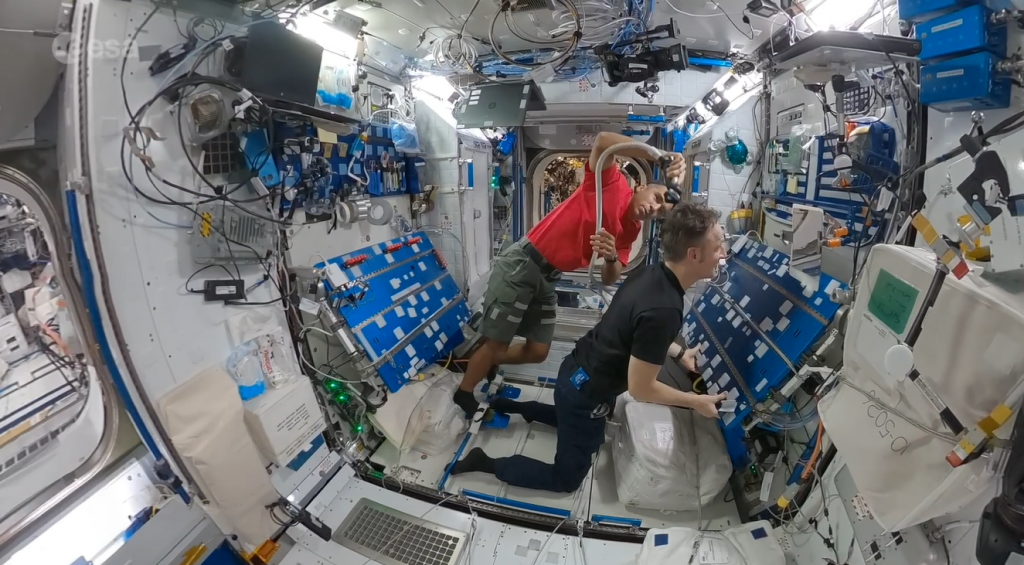
Matthias gets a haircut in space by NASA astronaut Raja Chari. Credit: ESA/NASA
How do you brush your teeth on the ISS?
Brushing your teeth is very similar to the ground. I put a little bit of toothpaste on my toothbrush, but much less than on the ground. I would say like the size of a of a pea, that’s enough. Otherwise, the toothpaste foams much stronger than on the ground. So, if you put a full line on your toothbrush, you have so much foam in your mouth that you could probably suffocate. Well, initially I did it like this and I thought like wow, I have to get rid of this foam. So, once you’re done, you just spit into a towel and it’s the towel that you used the week before. It’s just your absorber for spitting and then occasionally I also add a little bit of water in the mouth to rinse and spit out again, and then you put two drops of water on your toothbrush and the capillary effects of the brushes suck in the water. And I take this water from the toothbrush again, suck it into my mouth and spit it onto the towel. Then the toothbrush is clean, my mouth is clean, everything is clean and I’m happy.
What happens with the water droplets that float away? Aren’t they dangerous for the on-board electronics?
Yes and no. So basically, the washing areas that we have are in separate locations where we also have shower curtains and no critical electronics. In addition, all electronic outlets need to have caps on them. You would never leave an electronic outlet open, with all the pins open, so that fluid or dust can get into it. But it’s true, some computer systems have fans and areas where liquid could be pulled in, but I think the selection of all the hardware was made in a way to also protect from that. So, we should take care that we don’t spray liquid around and if there are droplets around, we should wipe them off. But the environment here is quite resilient and robust and can handle some small droplets.
Is there a maximum amount of drinking water per person per day on the ISS?
Yes, I believe there is a maximum drinking amount of water per day on the ISS. It’s basically because the system has limitations. I don’t know how high this limit is, but every one of us is asked to drink around 2.5 liters of water per day. That’s a medical requirement, a recommendation, and I think if you drink 3.5 liters per day, there’re also no constraints on the equipment. Especially when we have tourists here on board or a direct handover and we have a crew of up to 11 people, I think that’s when the system reaches more or less its maximum capacity. But I wouldn’t know that we ever had any constraints, and we were told to drink less. So basically, it’s always the opposite. People tell us to drink more because drinking a lot of water is good for health. But there is a limitation on the amount of water that we are allowed to use for personal hygiene and that is 250 milliliters a day. This is because all that water evaporates into the air and needs to be condensed out of the air and there is a limitation of our heat exchangers and the climate control on board of the ISS.
What room temperature do you have on the ISS and are all modules the same?
We have a very pleasant room temperature. The Russian segment is actually a little bit warmer than the US segment. But here in the US segment it’s warm enough to be in a t-shirt all day long and most of the time I even wear shorts. Sometimes the ground control team has to dry out the heat exchanger and that means they need to adapt the temperature. Then it gets a little bit colder, but we get a heads-up for this. Then we put on a sweater or a hoodie, long pants and so on. Also occasionally, if you have done a lot of workouts and you are hot and then you have a longer time of non-activity, you might feel cold. Then it’s also a good idea to drink a hot tea and then you are warm again. But I believe the temperature up here should be around mid-20°C I would say. I’m not sure, but it’s warm enough.
Did Covid-19 have an impact on you and your space flight?
Covid-19 had an impact on us in the preparation for the flight, of course we all had to wear masks and we also had to follow a strict quarantine protocol. But training was still possible. However, I was allowed to fly home a lot less and couldn’t see my family as much. This was a bit more demanding in the preparation period. But I think everyone on Earth has experienced struggles in the last two years.
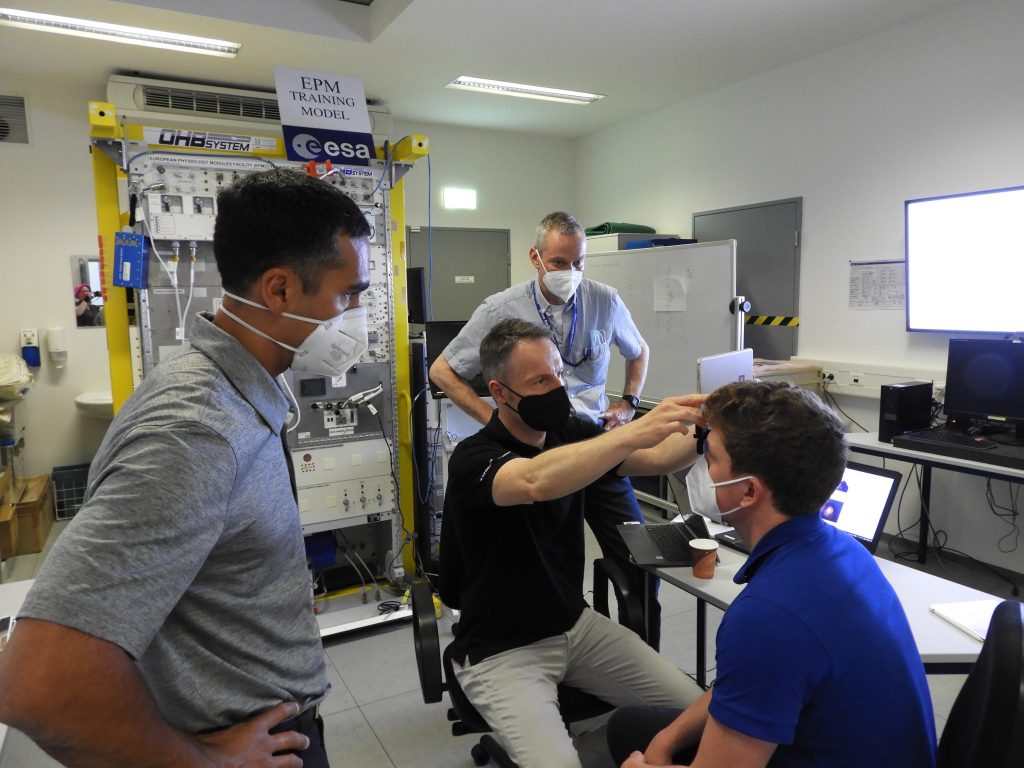
Matthias Maurer and NASA astronaut Raja Chari train in Retinal Diagnostics. Credit: ESA.
ISS Operations
How would it feel if the ISS suddenly lost air?
It would feel a bit like when you’re sitting in an airplane. The plane flies up and then it sinks down again, and then you notice the difference in pressure in your ears. That’s when your ears pop and that feeling is even more sensitive and reacts faster than a pressure gauge. But the pressure gauge on the ISS would also immediately trigger an alarm and that would come very shortly after the feeling in your ears. Then of course we have to measure the air pressure and try to find and fix the leak.
In an emergency, how fast could you return to Earth?
Well, we would get into our capsule and then check that the capsule is airtight, and if it’s airtight, then we would fly back. In principle, I would say the normal return to Earth can be done in less than six hours.
Space Science
Chilli peppers on the ISS: Do they taste any different from what is grown on the ground, are they spicier?
Oh yes, they were very hot indeed! These chilli peppers were grown by the previous crew aboard the International Space Station, but soon we also plan to grow other plants in the Columbus module. I will tell you more about that and send some more photos then. First of all, the goal is to understand what is growing in space, how things grow and can they be eaten?
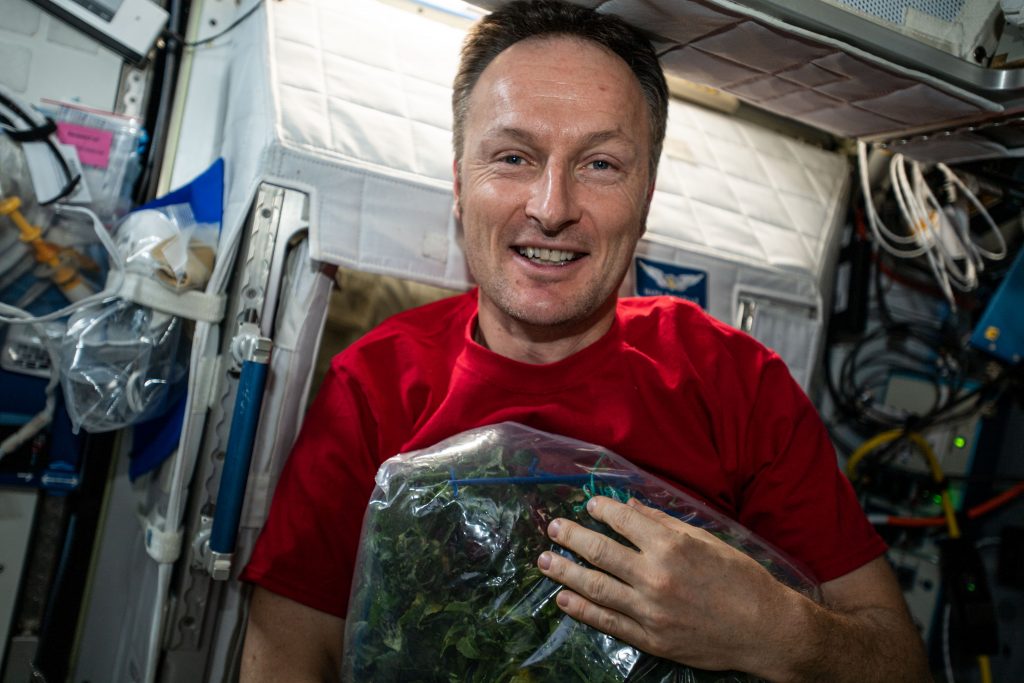
ESA Astronaut Matthias Maurer is pictured with a bag of leaves. Credit: ESA/NASA
Astrobee Robots in the future: Should robots also be used outside of space capsules or space stations?
Yes indeed. I mean, currently we have the robotic arm and send astronauts outside to work on the Station’s exterior, but it would be very nice to have a kind of drone that flies around the Station that’s able to inspect its outside. Astrobees are currently only approved for a small area in our modules, so they are not allowed to fly throughout the entire Station. This is because the Station changes almost every day. We have new setups, new experiments, new cables, astronauts moving around… At the moment, these indoor flying robots are not as intelligent as they need to be to be fully autonomous. We still need to take care of them and outside the Station it would be too difficult for us to retrieve them. But in the future, yes, that is definitely an application that we hope to see.
How long does foam remain stable in microgravity? Could you make whipped cream?
I think one of the experiments that was scheduled for me, I’m not sure if it still is in my list, is making a mousse au chocolate and this basically goes into this direction of making whipped cream. I think that would be very, very easy. The foam would be very stable and probably much foamier than on the ground. During my PhD I worked a lot with metallic foams, and there’s a term that is called ‘coarsening’. Small bubbles are less stable than bigger bubbles, so smaller bubbles disappear and then other small bubbles grow to bigger ones until you have a lot of big ones and then all the liquid, also along the walls, strains down. That’s an effect that makes foam on the ground instable as you all know from beer foam. But here in space such a foam would be much more stable.
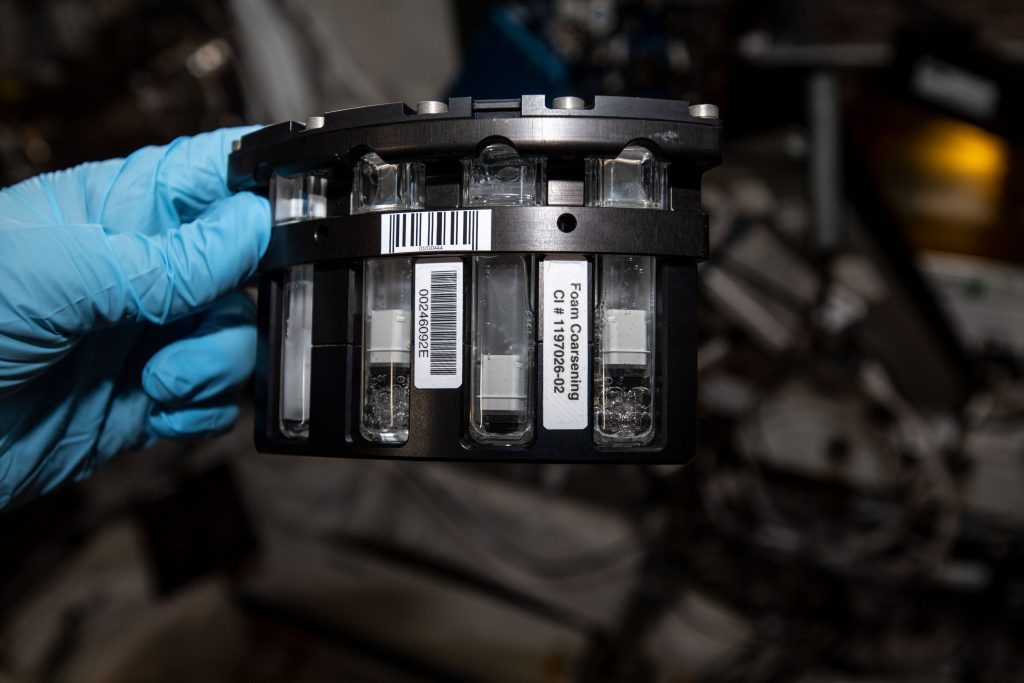
Foam-Coarsening experiment on ISS. Credits: ESA/NASA
Exercising in Space
Does the flight surgeon manage your workout schedule, or do they leave that up to you?
Well it’s not our flight surgeons, it’s our our fitness team from EAC (European Astronaut Centre) and there is kind of a fixed programme that you can do on the ARED (Advanced Resistive Exercise Device), which allows the crew to engage in resistive exercise onboard the ISS by simulating the use of free weights. The fitness team tries to vary this a little bit, but more or less it’s kind of a standard programme that most of us do and then the fitness team only adapts the weights according to what I have lifted beforehand and also according to their experience with previous spaceflights from colleagues of mine.
Why are you not wearing shoes on ARED?
Very good question, so I could wear shoes on ARED (Advanced Resistive Exercise Device), but these shoes have kind of like foamy soles. And so I prefer to have the direct contact with the base plate and to have all the force not being dumped by the shoes but going straight into the base plate. I also don’t like to wear socks because socks would make it slippery. I think most of us just go barefoot on the ARED, well, some come with shoes, but the others mostly prefer to do their workout barefoot.
How do the weights in Space feel compared to Earth? Do you have to lift more or less?
Well, the loads up here are much higher than on the ground because we have to add or own body weight. So I don’t only lift the weight that I would lift on the ground, but in addition I have my own body weight. In total I probably lift a little bit less then my body weight plus my maximum weight on the ground. I believe the absolute number up here in space is quite high, but it feels good.
Can the crew members do sports in parallel?
We do sports in parallel, but the ARED (Advanced Resistive Exercise Device) is the only device that we have that puts load into the body, so the ARED is a must. Everyone needs to have 1.5 hours of ARED training per day. Actually, scheduling ARED is a bottleneck and drives more or less the planning for the entire day on the station. For the cardio exercises, we have two exercises in the USOS part which is a bicycle (CEVIS) and the other one is a treadmill (T2) and you do either or and only the five USOS crew members use the treadmill or the bicycle. The Russian colleagues have their own treadmill which is, I would even say, more sophisticated than ours. It’s a really nice piece of hardware and they also have a kind of a bicycle which is not only a bicycle for the legs, but it’s also a bicycle that you can use with your arms. So, it’s also a very nice piece of hardware which I haven’t tried yet, but it’s definitely on my To-Do list to check it out.
Do you sweat the same as during your workout on Earth?
I actually sweat, or everyone sweats, differently up here. Maybe even more because on the ground, you have gravity. So you have circulation of air which means warm air rises and cold air comes from the bottom and gives you a nice cooling effect. Here in space, if you don’t switch on a fan, you sweat a lot. Your body overheats much quicker than on the ground because a lack of gravity means lack of convection. Convection is the active movement of air particles in this case. So, you sweat differently and after training with ARED, I usually have a completely wet head, the hair is wet and I sleep quite a lot. I have some colleagues who sweat a lot and then you can see lots of water droplets all around ARED or CEVIS and T2 after somebody has worked out. So, that’s quite different. But we also have fans that we always put on, otherwise you could not do the same amount of sports. Only on ARED we work without fans.
Doesn’t it get boring to do two hours of exercise per day or is it fun? Can you listen to music?
Well, of course you can listen to music. We have crew web, so I have Internet and as long as we have a good connection I usually listen to music or I watch the news to stay informed and to make the best out of this time. Yes, sometimes I feel like oh, I’m not in the mood to lift weights again and do the same exercises over and over again, like I do every day. So it is kind of a pain. Some people really love it and for me, it’s exercise, it’s a duty. I partially enjoy it because you need movement and with the workout your body feels much better, or afterwards I have to say, not during the activity. The biggest motivation is that if you don’t exercise, your bones and muscles would be in really bad shape when you get back home. So it’s not only about sports, it’s also about active prevention and maintaining your health. That’s why it’s a must.
Does the exercise fully mitigate against the muscle and bone loss that would occur without it?
I think there is still some gap in what we cannot do here in space, obviously with ARED (Advanced Resistive Exercise Device), CEVIS (Cycle Ergometer with Vibration Isolation Stabilization) and our treadmill T2 the condition post flight is much, much better than without using those devices. The first humans who went into space had to put up with much longer rehabilitation times and sometimes had problems for the rest of their lives afterwards. So, no, we can stop this bone and muscle loss to a large percentage, but I don’t think we can train the diagonal muscles enough. That’s why I brought an EMS suit (electro-muscle stimulation) to also trigger all the muscles that are not being activated so far with the training equipment we have up here, and we’ll see after the flight if that has an effect or if it’s just a wish that remains open. Personally, I think the EMS equipment is doing a great job and every time I wear them I feel like my body, my muscles, are waiting for those extra electrons and that extra stimulus. So maybe it has a positive effect up here, and maybe it will also help me to recover much faster than other colleagues. I remain curious. But I love it.
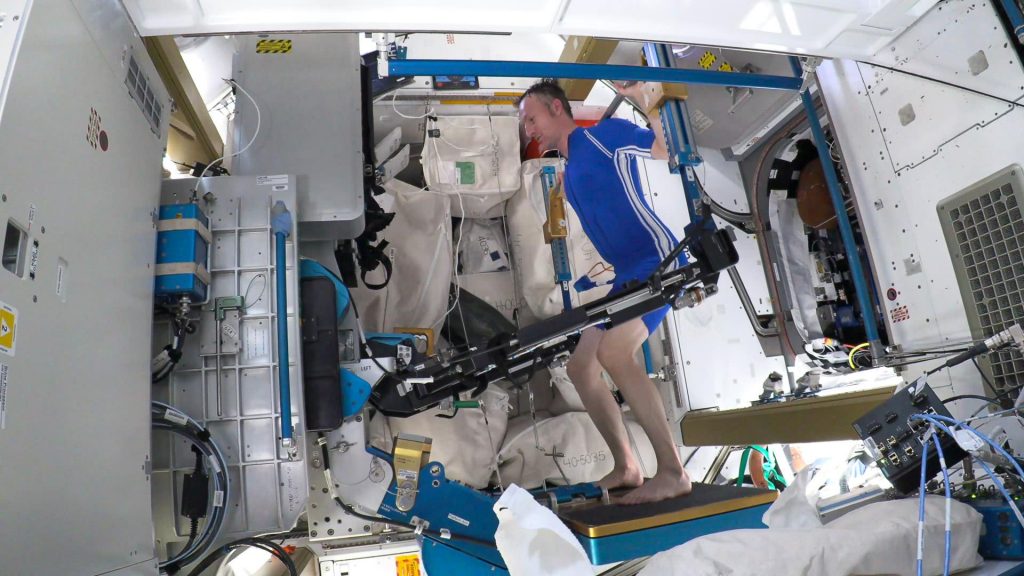
Weightless squats with the EasyMotion suit. Credits: ESA/NASA
Do you think there is still more to do for fitness equipment in space?
ESA is developing a new device that will also fly to the International Space Station soon. I believe in 2024 we will test it for the first time. And this new device is planned and designed for the Gateway [a new Space Station around the Moon]. So it’s supposed to be equally good as ARED, but much smaller in size, volume and weight. Plus, the Gateway station will be smaller and we won’t have a lot of room for this. Also, it is being considered for inclusion in potential spacecraft flying to Mars. I haven’t personally seen it, but it was tested by astronauts at NASA and they got a workout on it and gave good feedback. The Russians also have a different setup which works with a kind of weightlifting, but much smaller than the ARED, and it’s a bicycle where you lay down on your back and pedal, and you can also use your arms, so it’s kind of a multitool that you can also do certain exercises with that you can’t do with the ARED – a bit like in in a gym. We also had a flywheel being tested years ago, maybe that technology will come back and there are several ideas of what you could do in space to remain fit or to give stimulus to bones and muscles.
Is the energy you produce during your workout used for anything, like heat or electricity?
No, we have enough electricity coming from outside, for example from the solar panels. And all the electricity that is used and consumed to run the equipment generates heat, so we have enough heat in here. It is just pure workout and we don’t make anything else with it. That would not be enough.
The lack of gravity is affecting your blood circulation, do you have any physical issues?
That’s a good question. We have a fluid shift, and that means that we feel basically the same as when you lie in a bed with your head tilted down seven degrees. So basically, if you take a brick or two and put it under one end of the bed below the feet and then you lay in bed, your blood would flow slightly stronger towards your head. We don’t see as well as on the ground because this elevated fluid in the head also puts some pressure on or around the brain and pushes on our eyes and the optical nerve – an issue that is currently under investigation. Headaches have also been a major topic that has been investigated. I personally only felt in the first few days that I had not really a headache but a heavier head. Now I am used to this elevated pressure in my head, but I never had anything that I would describe as a headache. It’s all individual. I also think that if you do a lot of sports and you twist your neck a little bit, this might also trigger a headache. Otherwise, everything feels mostly normal apart from this fluid shift. You feel a little bit that your head and also your neck is a little bit wider in circumference. Some of the equipment that we test requires us to wear a shirt with a zipper that sits tightly around the neck. Also my EMS suit can feel uncomfortable up here in space because my neck circumference is wider than on the ground due to this fluid shift.
How did your body change in space?
In space, the body changes as the fluids shift. If you look at me now, you can see that my legs have become quite thin and that I have a bigger and rounder face. I don’t normally look like that. That happens because the fluid rises up from the legs into the upper body due to the lower gravity on the Space Station. Other than that, my muscles and bones naturally regress, and that’s why we have to exercise up here every day.
How do you keep yourself mentally fit?
For mental health, it is of course important that you sleep enough, that you have a balanced daily routine, that you also have a bit of fun and joy every day and that the work here doesn’t become too stressful. But the planners take care of that, and we have a talk with our doctors every week, and of course they ask if everything is okay. We also talk together in the crew every evening about what was good today, what was bad today, what was stressful today, and then we try to let go. It all works out very well.
Spacewalking/ Extravehicular Activities (EVA)
How can you breathe in a spacesuit?
A spacesuit is like a small spacecraft. It’s like a small room, or a small bubble and inside we have oxygen bottles for doing a spacewalk in the big spacesuits. So, we have the air that we need to breathe with us. In the case of a spacesuit for a spacecraft during launch and landing our suit is connected via an umbilical which is a hose-like connection, and this way oxygen is pumped into the suit. So that’s very easy.
Views from space & photography
How many times can you go and spend time in the cupola?
Outside of my work tasks, I am free to spend as much time as I’d like in the Cupola unless it is restricted due to Space Station operations. Whenever a spaceship arrives or departs, which can take several hours, all the windows must be shuttered to avoid the propellants the rockets use condensing on the windows and impairing the optical quality.
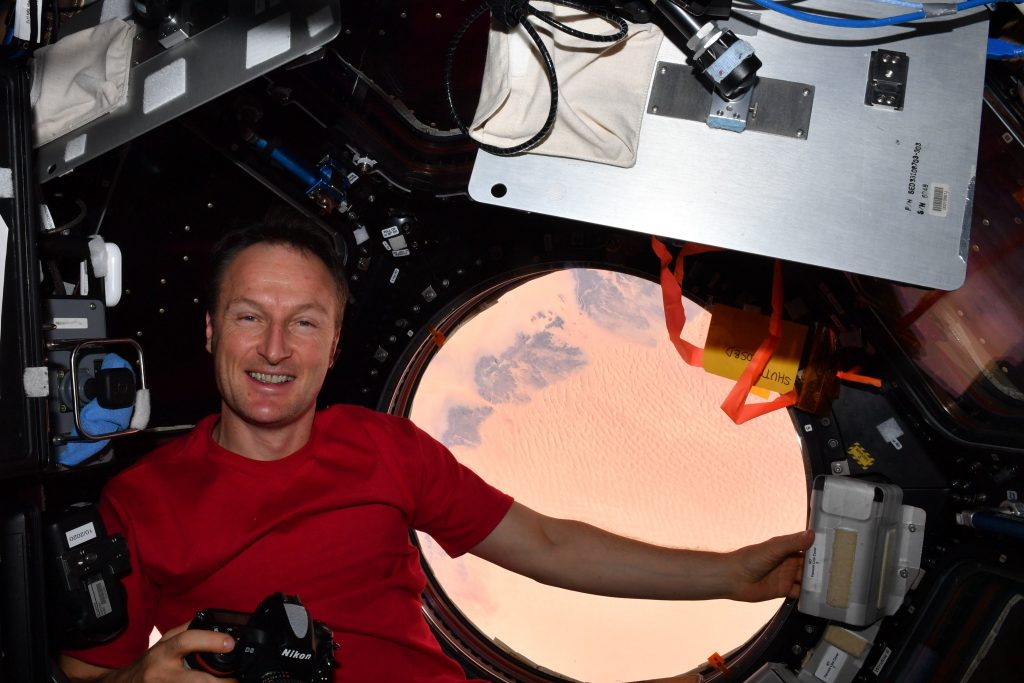
Matthias Maurer in the Cupola. Credits: NASA– Mark T. Vande Hei
Is it true that from space at a certain position above Earth, you can only see water?
We are flying at an altitude of 400 km, and I believe we can see a radius of around 2000/3000 km around the International Space Station. This means we don’t see the entire Earth, but we do see a large stretch of it. For example, we often pass over the US and then over the Atlantic Ocean, between Africa and Latin America, and then continue between Africa and Antarctica and over Australia. So basically, between the US and Australia we don’t see anything but water. 71% of Earth’s surface is covered by water, which I’ve become very aware of up here in space, and we actually fly over water most of the time. But passing from Africa over the Himalayas, Asia, and all the way over Japan, it’s actually a nice long pass over land, and it’s spectacular to see the Himalayas from up here, I can tell you.
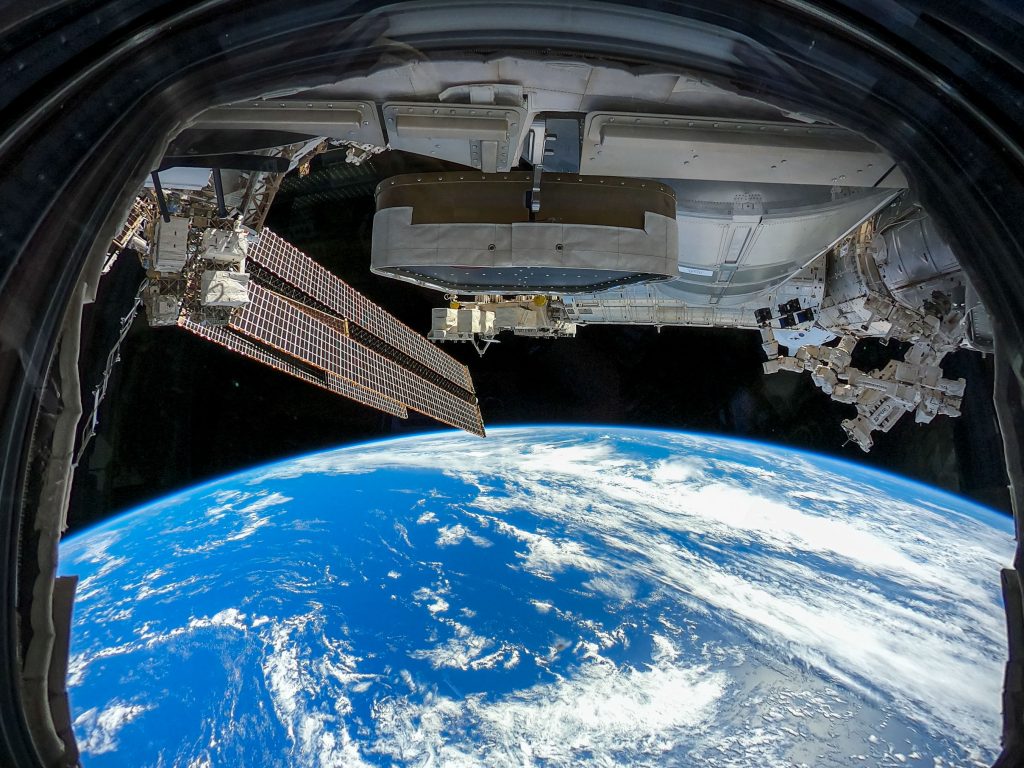
The south Pacific Ocean pictured from the International Space Station. Credit: ESA/NASA
Do sunsets and sunrises get boring after 16 per day?
No view from up here gets boring and I don’t have as much time e to watch the world out of the window as I would like to. We are here to do science and the labs don’t have windows, so I use my spare time. I try to spend at least 15 minutes to half an hour per day in the Cupola, looking out the window. Our planet is so beautiful and every time you fly over it, you discover something new.
Do you lose track of day and night on the ISS?
We experience sunrise and sunset 16 times a day. But you can only see that if you were looking out of the window all the time, but we don’t have any windows here in the western modules, including the Columbus module. But in the adjacent U.S. module, there is a window, and in the Cupola, of course, where we have lots of windows. That means if you are in the Cupola and float in there at night according to our time, then it can be daytime in there. That’s a bit confusing. But our daytime schedule is based on English or coordinated universal time. That’s the time our working schedule is based on and it doesn’t make any difference to us. We have the same 24-hour rhythm as on Earth.
Do you have the possibility to see the Moon from a better angle than on earth?
Yes, from up here I have the possibility to see the Moon from a better and also a completely different angle than from Earth. For example, I had a chance to really enjoy the last full Moon and observe it with my binoculars. A strange thing, but again perfectly logical, is that whenever I fly around Earth, I see the moon rotated by 180 degrees once. So, I always see the same part of the moon, but rotated by 180 degrees, from the other side of Earth, and during the transition, of course, I also see how the Moon rotates like a pointer blade, so to speak. That was quite interesting and also something I was not really aware of.
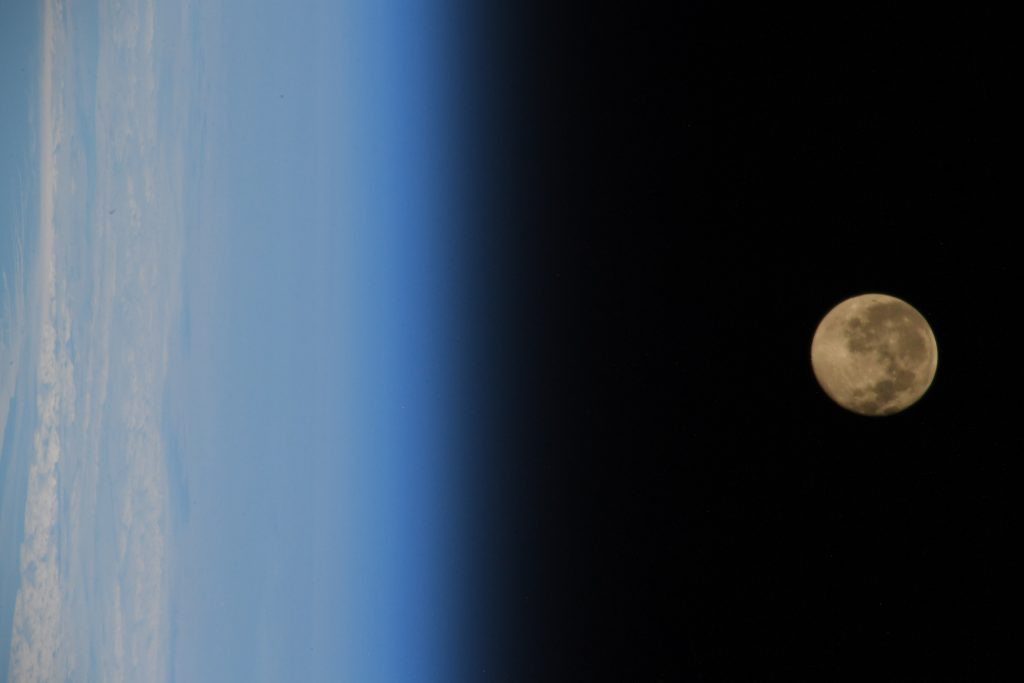
Moon and Atmosphere. Credit: NASA/ESA-M.Maurer
Has each astronaut, if they want, their own photography equipment with them, or do the cameras stay on the ISS?
The cameras always stay on the International Space Station, but each astronaut is assigned a camera to take photos of the experiments. In the Cupola and near the WORF (Window Observational Research Facility), our high-quality window in the lab, we get special cameras with pre mounted lenses, to take pictures very quickly. This means, we have some free floater cameras for macro photography and Earth observation, but for daily work on the space station, every astronaut uses his or her own camera.
If there was something with the windows could you fix it up there? Do they get scratched?
The Cupola windows are made of bulletproof glass and consist of several layers. Externally there are already very small impacts, but the inner layers remain stable. Inside the Space Station, the windows are also coated in Plexiglas. If the innermost panel of any window is heavily scratched, then it is replaced with a new one. These inner panels are known as “scratch panes”.
Is it always dark in space and do the stars in space shine brighter than on Earth?
Every 90 minutes we fly around the Earth. And every time we fly around the Earth, we also have a kind of night pass and a day pass. So, 16 times we see sunset and sunrise and, depending on the orbit, this is just a little bit longer or shorter than half of these 90 minutes. During the night pass we can see the sky and the stars in the sky. The difference is that the stars do not twinkle like on Earth. When we see stars from the ground the light passes through the atmosphere, which makes it appear more intense or less intense and causes a flickering effect. That is the difference that we see in space. The stars are almost equally as bright, but they are solidly bright and don’t have this twinkling effect that we see on the ground.
Can you spot monuments like the Pyramids or the Great Wall of China from space?
That is a very good question. If by you, you mean me, Matthias, have you already spotted the Pyramids or the Great Wall of China? I have to say no. I have been looking out, but so far I haven’t seen them but I know it is possible because colleagues of mine actually took a photo of the Great Wall of China. And the Pyramids, we can see, but not the Pyramid itself, you can only see the shadow of the Pyramid. So, we need to look out early in the morning and then the shadow is very long and next to it, we know where the Pyramids are, along the River Nile, and entering Egypt, that’s a very prominent area that we can spot easily here from space. But the Pyramids are built of a stone that is very similar to the surrounding sand. So, from space we can’t recognise the difference between the building and the sand. We can only recognise the Pyramids by their shadows and that is still on my high to do list. I am still hunting for the Pyramids.
Did you see the James Webb telescope fly by and could you take a picture of it?
No, when James Webb was launched in French Guiana, we were on the other side of the planet, so we were over Australia and we all missed the launch. But we wanted to follow it along through the Internet, so we had also a stream up here from the ground. But then, unfortunately, exactly during the launch time we were LOS, so loss of signal. We didn’t have any connection with the ground and only three minutes after the launch we reestablished radio contact and my first question to the ground was: How did it go? Is James Webb safely in space? And we got positive news so we were all really excited. Unfortunately, we missed the most critical moment.
How does your experience in space help show people that the Earth is not flat?
There is so much evidence, videos, and measurements that the Earth is not flat. People in the Middle Ages could already recognize that and when you see a ship sailing away from the harbour, you see the ship disappear, but you still see the tip of the mast of a sailing ship. So that means there is a lot of evidence that the Earth is not flat, but that it is round. Here on the ISS, I can see it from the Cupola and I take videos and photos where you can always see the curvature of the horizon. There is so much scientific evidence, that it is actually no question that the Earth is not flat.
Can you see the effects of climate change from the ISS?
Well, climate change can be observed much better with the help of satellites than I can from the space station, because climate change cannot be seen overnight, of course, but only over the years. But of course, I can see from up here that the rainforest is burning and I can also see that the polar ice caps or the glaciers have become much smaller than they appear on the maps. I also see that some lakes, such as the Aral Sea in Russia, have dried up completely. So, you can certainly see the effects of climate change from space, but not from day to day from my perspective.
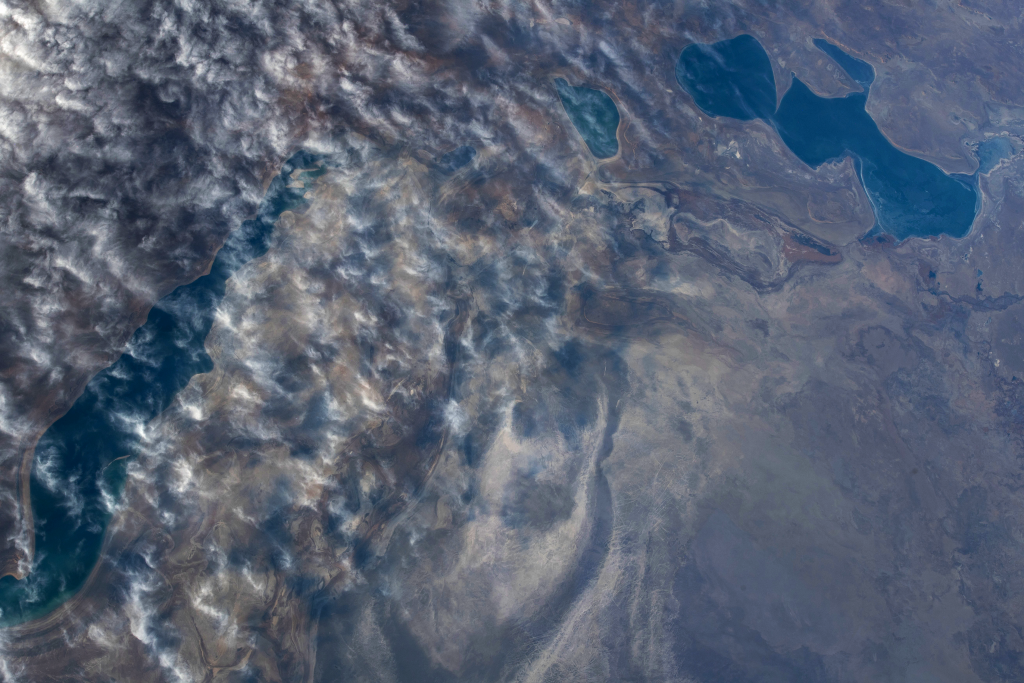
Aral Sea in Central Asia. Credits: ESA/NASA-M. Maurer
Spaceflight & Future of Space Exploration
What do you think would be the most important lesson learned for humankind from spaceflight today?
This is a very big question, almost a little bit philosophical. Obviously, we are up here in space because we want to do a lot of experiments, zero g experiments, there is a lot of stuff in physics, chemistry, medicine, that we can learn from being here in weightlessness and doing this research. But I think that is so complicated for a lot of people that they don’t understand exactly the details of what we are doing and the most important lesson for humankind is: look at them flying in the International Space Station, they are working together, they were people having a dream, like that was 30 years ago, let’s build a Station in the sky and everyone around the world can propose science objectives for this Station. We will send astronauts from many countries up there. We will work peacefully. And now, having this Station already in space for around 23 years we can demonstrate that we as humans, if we work together, we can achieve so much. There is almost no obstacle that can hold us down. So, we need to work together, that is the biggest message from space. And for us astronauts, looking down on our planet Earth we don’t see any borders, we don’t see any frontiers. It’s just like one huge spaceship Earth and you guys down there are all astronauts on this spaceship Earth, so if you work together, you can do the same for planet Earth that we have achieved for the International Space Station.
Has your view of the world changed as a result of your job?
When you’re up here, you see how thin and fragile the Earth’s atmosphere is. From up here, it looks almost like a soap bubble, so very, very thin. At the beginning, I was totally shocked and thought, we have to take much, much, much better care of our Earth. What we’re doing down there is all way too rough and everything we have is based on the fact that we have the Earth’s atmosphere to protect us. Beyond Earth’s atmosphere is nothing but space, there is a vacuum where you can only work and survive with a space suit, but this is certainly not a solution for Earth.
Do you think we will find extraterrestrial life and where?
The question of “where?” is very difficult to answer. So where out there extraterrestrial life is to be found, that is the 1000 Euro question I would say. But that there is extraterrestrial life, that is for me almost certain. The probability that it exists is simply far greater than winning the lottery and every weekend someone wins the lottery.
What is your opinion on space tourism?
I think space tourism is a double-edged sword, of course. On the one hand, you want a lot of people to come up and enjoy the view of the Earth, just like I do. I wouldn’t want to deprive that from anyone, and these people would then also become ambassadors for a better way of treating our Earth. But on the other hand, of course, every rocket launch is tied to waste and debris, and then we have to find a good compromise. But I think in 100 years it will be as normal to fly into space as it is today to get on a plane and fly to Spain for your holidays, for example.


